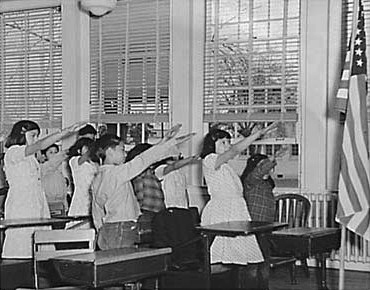In 1887, Capt. George Balch wanted to encourage immigrants to be loyal to their new country. He came up with a pledge: “We give our heads and hearts to God and our country: one country, one language, one flag!” Balch, a Civil War veteran, pushed schools to display flags. Ralph Bellamy was a minister’s son who became a minister. In 1892, he went to work for a magazine called “Youth’s Companion”. The magazine’s owner had the idea of selling flags to schools as part of a promotion. Bellamy wrote a pledge to go with the campaign. He felt the Blach pledge was “too juvenile and lacking in dignity”. On Sept. 8, 1892, it appeared in the magazine. “I pledge allegiance to my flag, and the Republic, for which it stands – one nation, indivisible with liberty and justice for all”. Leaflets were sent to schools nationwide. It was suggested the flag be saluted with one hand raised towards it. On Oct. 12, 1892, in commemoration of the 400th anniversary of Columbus discovering America, millions of schoolkids recited the Pledge. (Columbus Day became a national holiday that same year.) In 1923, at the National Flag Conference, the American Legion and the Daughters of the American Revolution pushed for a revision because they feared immigrant children might say “my flag” and think of their home country. “My flag” was replaced by “the flag”. For better cadence, “to” was placed before “the Republic”. The National Flag Conference also decided that the Balch pledge, which was being said in conjunction with Bellamy’s pledge, was being redundant. At the National Flag Conference in 1924, “of the United States of America” was placed after Republic to make it even more clear what country’s flag was being pledged to. In 1942, on the 50th anniversary of the Pledge, the pledge was added to the National Flag Code. Later that year, Franklin Roosevelt signed a law replacing the “Bellamy Salute” (because it resembled the Nazi salute) to holding your right hand over your heart. In 1943, the Jehovah’s Witnesses sued because their children were being forced to worship a graven image. The Supreme Court ruled against the plaintiffs. In 1954, because of the Red Scare, the Knights of Columbus pushed for a reference to God as a counter to godless communism. “Under God” was added. On June 14, 1954, Pres. Eisenhower signed the law on Flag Day. (“In God We Trust” was added to coins for the same reason.) The Pledge has been challenged several times for its supposed violation of the separation of church and state due to “under God”. The Supreme Court has determined it does not violate the 1st Amendment, but it has ruled that students can not be forced to recite the Pledge. However, all states require school-wide recital of the Pledge except Nebraska, Hawaii, Vermont, and Wyoming.
https://www.thoughtco.com/pledge-of-allegiance-brief-history-3320198
https://www.smithsonianmag.com/history/the-man-who-wrote-the-pledge-of-allegiance-93907224/
https://en.wikipedia.org/wiki/Pledge_of_Allegiance

The Bellamy Salute
0 Comments